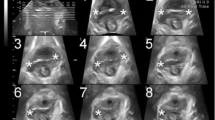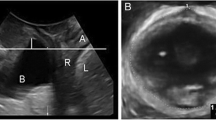Abstract
Introduction and hypothesis
Levator avulsion is associated with prolapse and prolapse recurrence after reconstructive surgery. We set out to determine whether clinical measurement of the genital hiatus and the perineal body (gh + pb) on maximum Valsalva can predict levator avulsion.
Methods
A total of 295 women attending a tertiary referral service underwent 4D translabial ultrasound imaging and clinical examination using the International Continence Society (ICS) Pelvic Organ Prolapse Quantification system (POP-Q). Analysis of ultrasound data sets for levator avulsion was performed using tomographic ultrasound imaging. The predictive performance of gh + pb for avulsion was tested using receiver-operating characteristic curves.
Results
Optimal sensitivity [70 %, 95 % confidence interval (CI) 59–79 %] and specificity (70 %, 95 % CI 66–72 %) were achieved with a cut-off of 8.5 cm for gh + pb.
Conclusions
A gh + pb measurement ≥ 8.5 cm may help to identify women with levator avulsion who are at increased risk of prolapse recurrence.



Similar content being viewed by others
Abbreviations
- MRI:
-
Magnetic resonance imaging
- 4D:
-
Four-dimensional
- ICS POP-Q:
-
International Continence Society Pelvic Organ Prolapse Quantification system
- PFMC:
-
Pelvic floor muscle contraction
- TUI:
-
Tomographic ultrasound imaging
- LUG:
-
Levator urethra gap
- ROC:
-
Receiver-operating characteristic curve
- OR:
-
Odds ratio
- RR:
-
Relative risk
- ICC:
-
Intraclass correlation coefficient
References
Singh K, Reid WM, Berger LA (2002) Magnetic resonance imaging of normal levator ani anatomy and function. Obstet Gynecol 99:433–438
Dietz HP, Lanzarone V (2005) Levator trauma after vaginal delivery. Obstet Gynecol 106:707–712
DeLancey JO, Kearney R, Chou Q, Speights S, Binno S (2003) The appearance of levator ani muscle abnormalities in magnetic resonance images after vaginal delivery. Obstet Gynecol 101:46–53
Lien KC, Mooney B, DeLancey JO, Ashton-Miller JA (2004) Levator ani muscle stretch induced by simulated vaginal birth. Obstet Gynecol 103:31–40
Dietz HP, Steensma AB (2006) The prevalence of major abnormalities of the levator ani in urogynaecological patients. BJOG 113:225–230
Shek KL, Dietz HP (2009) The effect of childbirth on hiatal dimensions. Obstet Gynecol 113:1272–1278
DeLancey JO, Morgan DM, Fenner DE et al (2007) Comparison of levator ani muscle defects and function in women with and without pelvic organ prolapse. Obstet Gynecol 109:295–302
Dietz HP, Simpson JM (2008) Levator trauma is associated with pelvic organ prolapse. BJOG 115:979–984
Weemhoff M, Vergeldt TF, Notten K, Serroyen J, Kampschoer PH, Roumen FJ (2012) Avulsion of puborectalis muscle and other risk factors for cystocele recurrence: a 2-year follow-up study. Int Urogynecol J 23:65–71
Dietz HP, Chantarasorn V, Shek KL (2010) Levator avulsion is a risk factor for cystocele recurrence. Ultrasound Obstet Gynecol 36:76–80
Olsen AL, Smith VJ, Bergstrom JO, Colling JC, Clark AL (1997) Epidemiology of surgically managed pelvic organ prolapse and urinary incontinence. Obstet Gynecol 89:501–506
Wong V, Shek KL, Goh J, Rane A, Dietz H (2011) Should mesh be used for cystocele repair? Long-term outcomes of a case–control series. Int Urogynecol J 22(Suppl 1):S91
Dietz H, Shek K, Moegni F (2012) Diagnosis of levator avulsion injury: a comparison of three methods. Ultrasound Obstet Gynecol. doi:10.1002/uog.11190
Kearney R, Miller JM, Delancey JO (2006) Interrater reliability and physical examination of the pubovisceral portion of the levator ani muscle, validity comparisons using MR imaging. Neurourol Urodyn 25:50–54
Bump RC, Mattiasson A, Bø K et al (1996) The standardization of terminology of female pelvic organ prolapse and pelvic floor dysfunction. Am J Obstet Gynecol 175:10–17
Khunda A, Shek KL (2012) Can ballooning of the levator hiatus be determined clinically? Am J Obstet Gynecol 206:246.e1–246.e4
Abdool Z, Shek K, Dietz H (2009) The effect of levator avulsion on hiatal dimension and function. Am J Obstet Gynecol 201:89.e1–89.e5
Dietz HP (2004) Ultrasound imaging of the pelvic floor. Part 1: two-dimensional aspects. Ultrasound Obstet Gynecol 23:80–92
Dietz HP, Bernardo MJ, Kirby A, Shek KL (2011) Minimal criteria for the diagnosis of avulsion of the puborectalis muscle by tomographic ultrasound. Int Urogynecol J 22:699–704
Dietz HP, Wong V, Shek KL (2011) A simplified method for determining hiatal biometry. Aust N Z J Obstet Gynaecol 51:540–543
Dietz H, Shek C, De Leon J, Steensma AB (2008) Ballooning of the levator hiatus. Ultrasound Obstet Gynecol 31:676–680
Dietz HP, Franco AV, Shek KL, Kirby A (2012) Avulsion injury and levator hiatal ballooning: two independent risk factors for prolapse? An observational study. Acta Obstet Gynecol Scand 91:211–214
Conflicts of interest
Dr. Volloyhaug has accepted speaker’s fees from Astellas and received travel and congress expenses from Pfizer, travel and course expenses from Johnson and Johnson. Dr. Dietz has, within the last 2 calendar years, acted as a consultant for American Medical Systems (Minnetonka, MN, USA) and Materna Medical Inc. (San Francisco, CA, USA) and has received an educational grant from GE Medical.
Author information
Authors and Affiliations
Corresponding author
Rights and permissions
About this article
Cite this article
Volloyhaug, I., Wong, V., Shek, K.L. et al. Does levator avulsion cause distension of the genital hiatus and perineal body?. Int Urogynecol J 24, 1161–1165 (2013). https://doi.org/10.1007/s00192-012-1993-7
Received:
Accepted:
Published:
Issue Date:
DOI: https://doi.org/10.1007/s00192-012-1993-7




